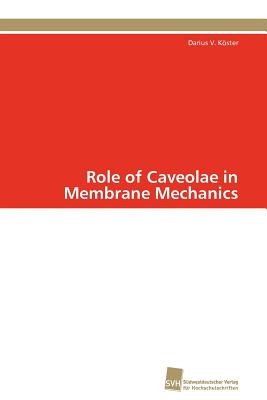
- We will send in 10–14 business days.
- Publisher: Sudwestdeutscher Verlag Fur Hochschulschriften AG
- Year: 2011
- Pages: 220
- ISBN-10: 3838127129
- ISBN-13: 9783838127125
- Format: 15.2 x 22.9 x 1.3 cm, softcover
- Language: English
- SAVE -10% with code: EXTRA
Role of Caveolae in Membrane Mechanics (e-book) (used book) | bookbook.eu
Reviews
Description
Caveolae, the characteristic plasma membrane invaginations present in many cells, have been associated with numerous functions that still remain debated. Taking into account the particular abundance of caveolae in cells experiencing mechanical stress, it was proposed that caveolae constitute a membrane reservoir and buffer the membrane tension upon mechanical stress. The present work aimed to check this proposition experimentally. First, the influence of caveolae on the membrane tension was studied on mouse lung endothelial cells in resting conditions using tether extraction with optically trapped beads. Second, experiments on cells upon acute mechanical stress showed that caveolae serve as a membrane reservoir buffering surges in membrane tension in their immediate, ATP- and cytoskeleton-independent flattening and disassembly. Third, caveolae incorporated in membrane vesicles also showed the tension buffering. Finally, in a physiologically more relevant case, human muscle cells were studied, and it was shown that mutations with impaired caveolae (described in muscular dystrophies) render muscle cells less resistant to mechanical stress.
EXTRA 10 % discount with code: EXTRA
The promotion ends in 20d.21:44:01
The discount code is valid when purchasing from 10 €. Discounts do not stack.
- Publisher: Sudwestdeutscher Verlag Fur Hochschulschriften AG
- Year: 2011
- Pages: 220
- ISBN-10: 3838127129
- ISBN-13: 9783838127125
- Format: 15.2 x 22.9 x 1.3 cm, softcover
- Language: English English
Caveolae, the characteristic plasma membrane invaginations present in many cells, have been associated with numerous functions that still remain debated. Taking into account the particular abundance of caveolae in cells experiencing mechanical stress, it was proposed that caveolae constitute a membrane reservoir and buffer the membrane tension upon mechanical stress. The present work aimed to check this proposition experimentally. First, the influence of caveolae on the membrane tension was studied on mouse lung endothelial cells in resting conditions using tether extraction with optically trapped beads. Second, experiments on cells upon acute mechanical stress showed that caveolae serve as a membrane reservoir buffering surges in membrane tension in their immediate, ATP- and cytoskeleton-independent flattening and disassembly. Third, caveolae incorporated in membrane vesicles also showed the tension buffering. Finally, in a physiologically more relevant case, human muscle cells were studied, and it was shown that mutations with impaired caveolae (described in muscular dystrophies) render muscle cells less resistant to mechanical stress.


Reviews